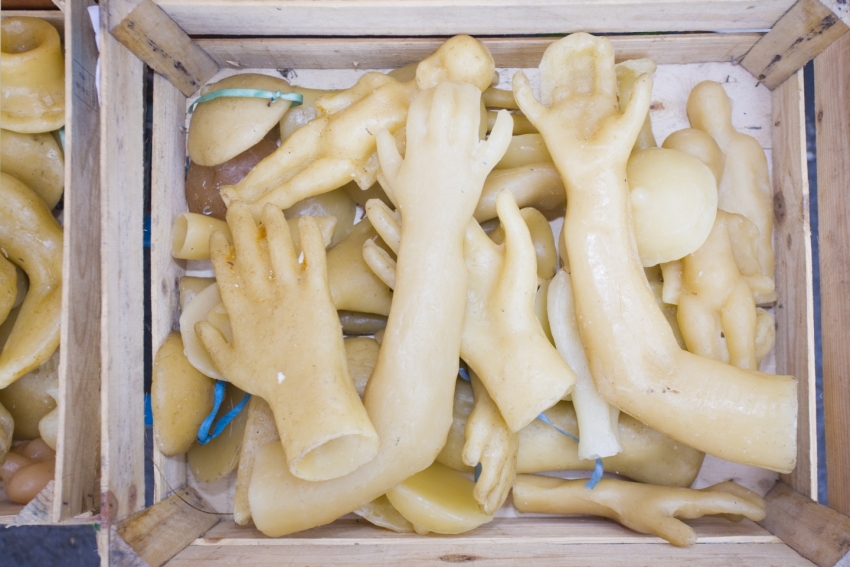Alex Bramwell
The Parafarmacia In Gran Canaria Is Not A Chemist!
If there is one thing we hate it is visitors being tricked in Gran Canaria. In the past we've warned about overcharging at Gran Canaria chemists, and rip off electronics shops in resorts.
In this Tip Of The Day we return to the island's chemists or rather, to the island's fake chemists.
A chemist in Gran Canaria is called a Farmacia and always has a green cross sign. Farmacias are the only place tobuy medicine in Spain, even basics like paracetamol.
However, there is another kind of shop in Gran Canaria that looks and sounds like a chemist but doesn't sell medicine. This is the Parafarmacia and it also uses a green cross sign.
A parafarmacia is a herbal medicine shop that is not allowed to sell any normal medicine such as paracetamol, ibuprofen or antibiotics.
Instead, parafarmacias sell herbal alternatives to medicine but don't have to prove that they work and they can charge whatever they want.
We recently heard from a visitor to Gran Canaria who went into a parafarmacia and was charged 40 euros for a herbal alternative to Ibuprofen. It was only when they read the label that they realised what had happened.
To locate a genuine farmacia, see this website and search within your municipio (Puerto Rico is in Mogán, Playa del Inglés is in San Bartolomé de Tirajana). At weekends and on fiesta days many farmacias close but there is always one open, known as the farmacia de guardia, in each municipio.
Search for the nearest one to you with this tool.
Lex Says: To keep costs down, see this article for the way to ask for generic medicine rather than expensive branded alternatives.
At Last: Good Paella In Gran Canaria
Rather like tapas, paella isn't a traditional dish in the Canary Islands and finding a good one in Gran Canaria has always been difficult.
Proper paella is not pukka
Proper paella hails from the Valencian region and is made from chicken, rabbit and snails. What visitors think of as paella, yellow rice with prawns, mussels and calamares, is actually a completely different dish called arroz a banda.
The Valencians are quite defensive about the origins and authenticity of paella because it is one of the most abused dishes on Earth.
Proper paella is two grains of rice thick, not bright yellow, and each mouthful is a blast of flavour. The stuff you get in most Gran Canaria resort restaurants, and even local restauarants, is a long way removed from the real thing. In fact if you find paella on a restaurant menu and the waiter doesn't warn you about how long it will take, you know it's coming out of the freezer.
Proper paella in Gran Canaria
Paella takes a while to cook so most local restaurants only do it on Sundays. Even when they do it tends to be too thick and bright yellow to be authentic. These local paellas can be delicious but are never quite as good as the real deal.
To try the real deal, find local restaurants called arrocerias which specialise in rice dishes. The most accessible in south Gran Canaria is El Caldero along the Meloneras strip. This serves paella, and arroz a banda, cooked over flames with the right amount of rice and spices (as you can see from the photo, it isn't bright yellow). If you feel adventurous, try the black rice (cooked and coloured with squid ink).
Alex Says: Paella servings At El Caldero are generous so four people will struggle to eat "paella for four". It's best to order paella for two or three, especially if you order starters.
Hestia: Tasting Restaurant In Las Palmas
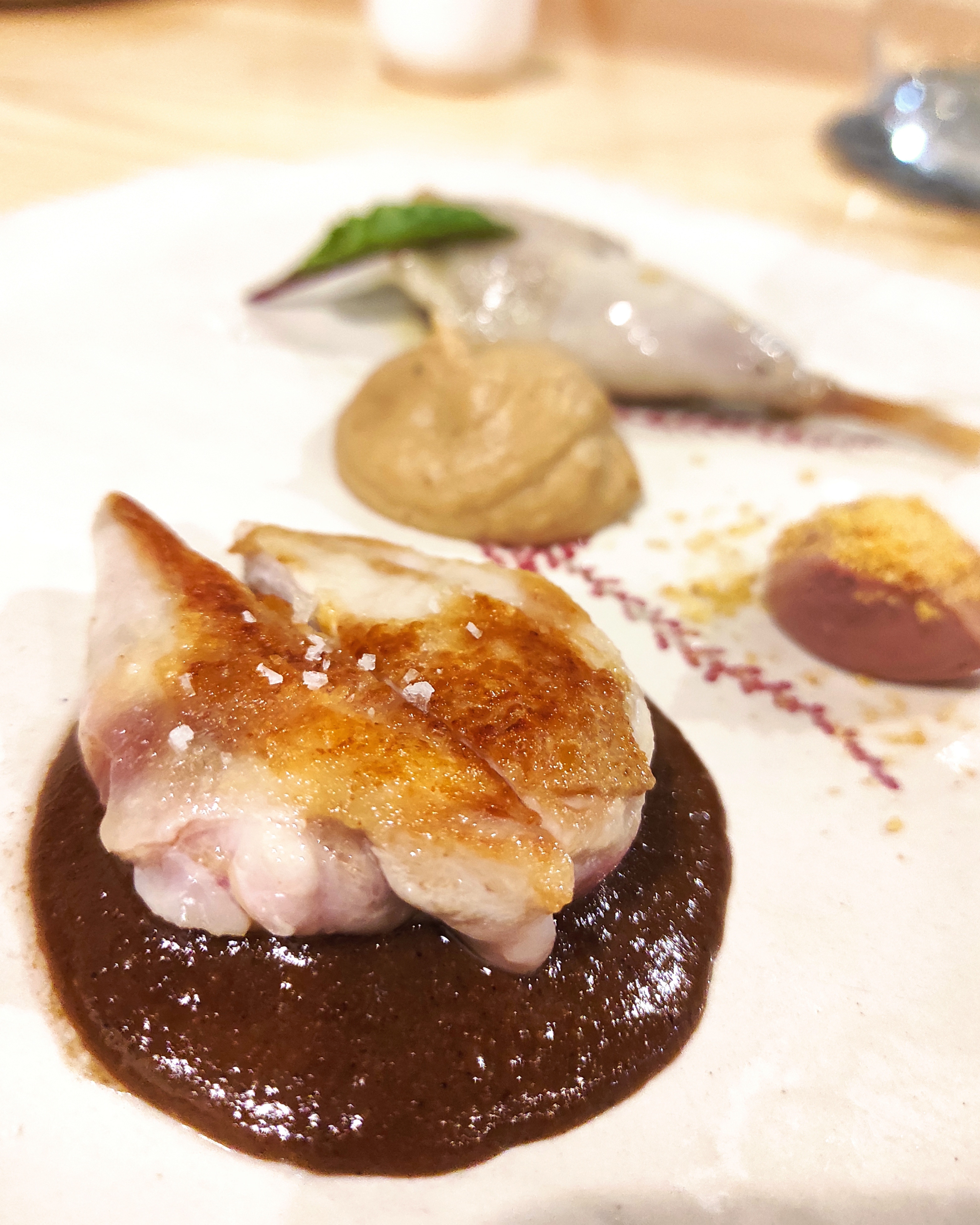 The tasting menu has now established itself in Gran Canaria. Every restaurant with a even a distant dream of getting in the Michelin guide, let alone bagging a star, has a multi-course extravaganza on the menu. In exchange for most of the contents of your bank account they give you seven courses (if you are lucky), three desserts, and wines to match.
The tasting menu has now established itself in Gran Canaria. Every restaurant with a even a distant dream of getting in the Michelin guide, let alone bagging a star, has a multi-course extravaganza on the menu. In exchange for most of the contents of your bank account they give you seven courses (if you are lucky), three desserts, and wines to match.
The trouble with this extravaganza of flavours is that, like a night out at carnival, it can overwhelm the senses and the stomach. A little bit of a lot of things can be extremely filling, especially if washed down with a wide variety of wines. That said, tasting menus can also be a good way to find out what a restaurant offers without working your way through the whole menu.
Hestia: Las Palmas tasting menu
We headed to Hestia to try their tasting menu with empty tummies and high expectations as several friends have recommended it as amongst the best in Las Palmas.
The restaurant is tucked away on Leon Tolstoy close to the beach. All tables are indoors but that's not a problem on a March evening in Las Palmas. It's decorated like all smart restaurants are decorated at the moment: A a nod to mid-century modern, a vintage touch, a pop of pastel colour, and that round Ikea mirror with the Mobius strip frame that is everywhere. All perfectly pleasant without giving anything away about the origins or inspirations of the chef.
There isn't much more information online or on social media. Rather enigmatic, or maybe we just don't read the right magazines. Anyway, here's the young chef's Instagram and here's Hestia on Facebook.
The tasting menu at Hestia in Las Palmas
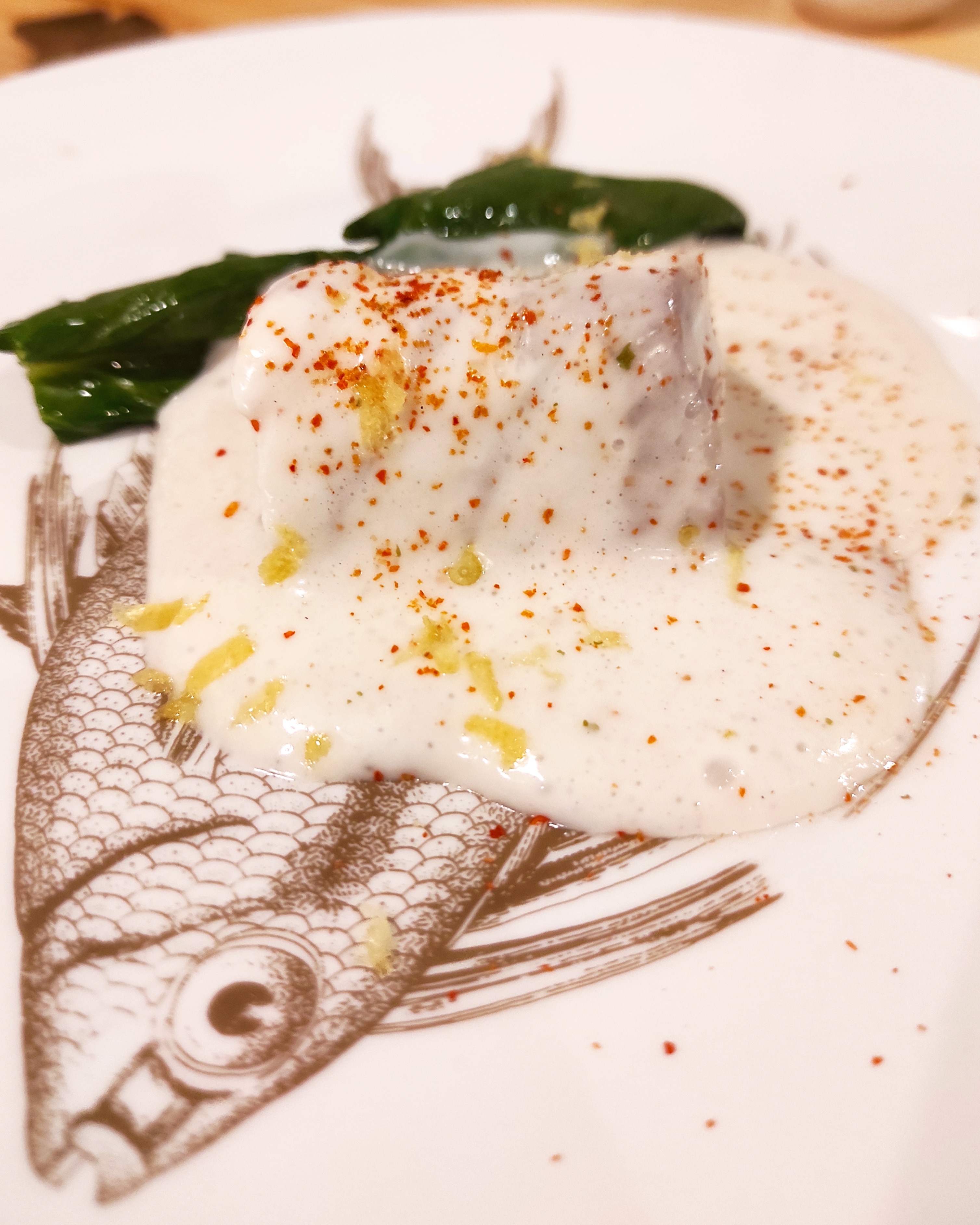 We opted for Hera, the shorter of the two tasting menus.
We opted for Hera, the shorter of the two tasting menus.
First up, tasty welcome snacks with instructions about the order to eat them in (pet hate).
Then, a vegetable tartlet with local goat cheese. Thin, crispy pastry but not quite enough of the sharp cheese to offset the rich filling.
A smoked risotto with boletus mushrooms, green beans and pine nuts that was superb.
Marinated amberjack (it was tuna on the night) with tomato sorbet. Well balanced, if unnervingly cold.
Slow cooked seabass in coconut and lime bechamel which was possibly the best bit of fish I've ever eaten.
A medley of partridge; breast, pate and leg; all tasty and well dressed.
The first dessert was a dense chocolate mousse with forest fruits and two blobs of what seemed to be HP Sauce.
The second desssert a delicious banana cream millefeuille with manadarin sorbet
The petit fours were yummy, especially the mini Oreo.
Each course served with a small glass of wine including a dry white from Los Berrezales in Agaete, a great sweet Madeira, a sake, a cava, a Spanish red, and the lingering dread of an inevitable fuzzy head the next morning.
The service was friendly and prompt and the explanations of each dish brief and useful.
To Hestia or not to Hestia
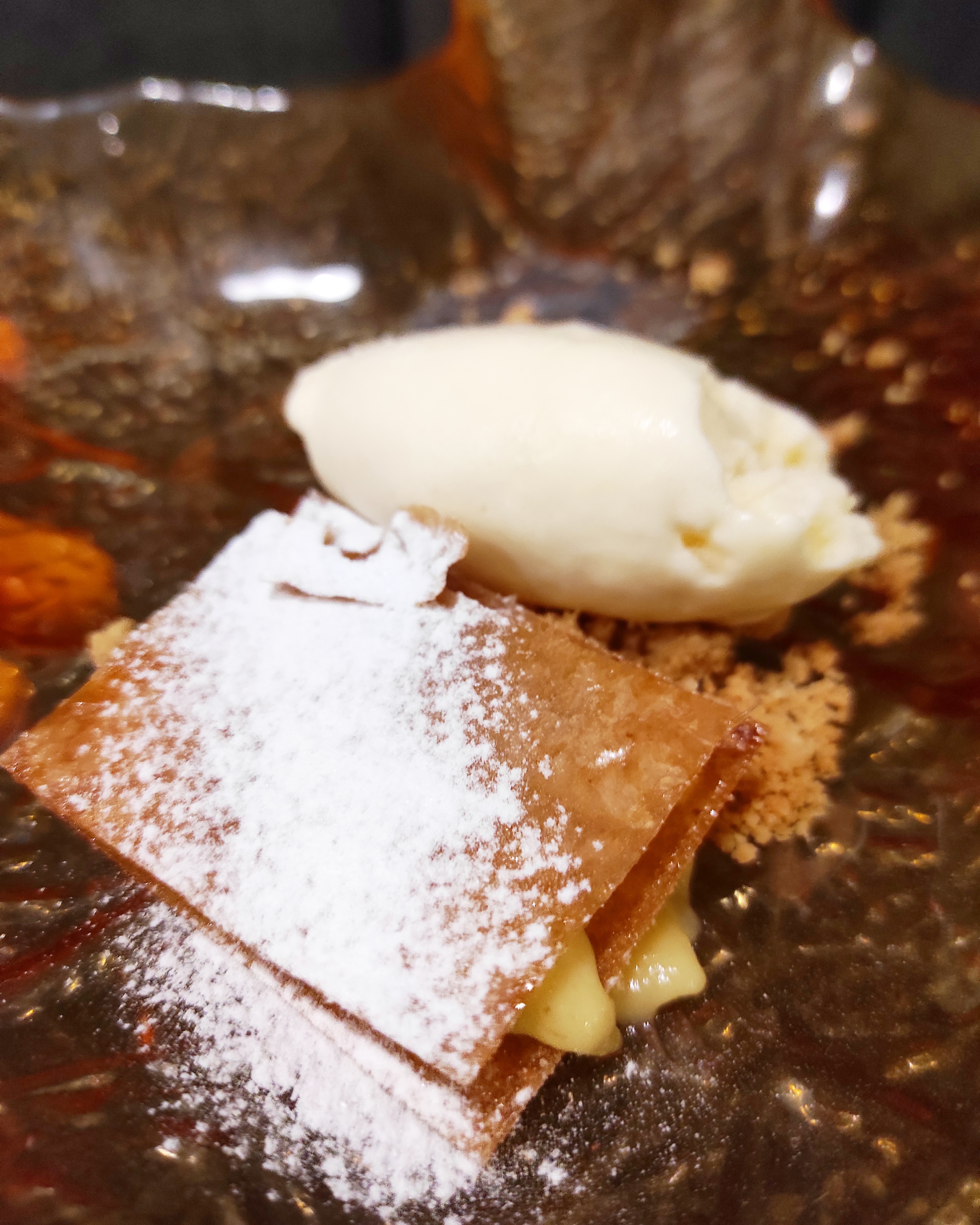 This is a quality restaurant that uses top notch ingredients and puts a lot into every dish it serves. The Hestia tasting menu (59 euros) plus wines (39 euros) was good value. Individual dishes on the menu range from 15-25 euros.
This is a quality restaurant that uses top notch ingredients and puts a lot into every dish it serves. The Hestia tasting menu (59 euros) plus wines (39 euros) was good value. Individual dishes on the menu range from 15-25 euros.
The smoked risotto and the coconut seabass were top notch. The chef also deserves kudos for making something delicious out of cooked banana because it's a tricky thing to pull off. There was also a pea pasta with Spanish ham sauce and sage oil that sounded delicious and we'll be back to try it.
We'd definitely recommend Hestia as a tasting menu option for a couple, or foodie group, in Las Palmas.
Gran Canaria: There Is No Such Thing As Tapas
One of the first things visitors arriving in Gran Canaria ask us is where they can get the best tapas. The answer isn't easy because there is no such thing as tapas and tapas restaurants as they exist in people's minds.
The tapa exists of course (although it can also be called a pincho) but there are no tapas restaurants in Spain outside of tourist resorts.
The tapa in Spain
Bars in Mainland Spain serve an individual free tapa with every drink knowing that make people more liklely to stay for another one. But, unlike the Greeks with their meze, the Spanish never sit down at a restaurant for a table full of little plates of tapas.
In the Canary Islands the tapa itself isn't regarded as a local thing. Nor, for that matter is paella which is from Valencia.
There are Spanish bars and restaurants in many towns and in Las Palmas that do serve tapas as part of their menu. Look out for jamonerias which do tapas and Spanish ham by the plate.
Vegueta Old Town in Las Palmas hosts a weekly tapas night on Thursdays but the focus is more on volume than quality. Most of the tapas served are actually montaditos; something on a bit of bread. A better option is to head to the Mercado del Puerto just by north end of Las Canteras beach. This Eiffel-designed iron building contains a mix of fresh food stalls and tapas stalls and has been voted amongst the best 10 food markets in Spain.
Pre-Covid, resorts in Gran Canaria were hosting regular tapas evenings and we really hope that these come back soon.
The Canary Islands equivalent to tapas
A few years ago the tourism authorities dug up the word enyesque as a Canary Islands equivalent to tapas. The term didn't really take off.
These days there are occasional enyesque events where bars and restaurants in a town offer one dish each over a weekend.
To find the best tapa-equivalents in Gran Canaria you have to look around: Many local Gran Canaria bars serve snacks, often displayed on the bar. Look out for Ensaladilla Rusa, croquetas, tortilla Española, etc.
Or order several dishes from the starter menu at local restaurants for that holiday tapas feeling.
The Tajinaste Trail: Gran Canaria's Most Spectacular Spring Walk
Between March and the end of April the chunk of Gran Canaria between the Caldera de los Marteles and Tenteniguada, high up in the hills above Telde, goes technicolour.
This spring explosion of colour comes from a range of native species with purple, blue, yellow and red flowers. The most famous are the tajinastes or viper's bugloss flowers but buttercups, aeoniums, cinerarias, poppies and sonchus (giant dandelions ) all flower here at the same time.
Most of the tajinastes are blue, pink or purple but the challenge is to spot one of the rare red flowered plants.
You can walk a long loop from the Caldera de los Marteles down to Tenteniguada (about 6km) and back up again but the bulk flowers are within a kilometre of the road just past the clump of pine trees. There is no bus back up so you either walk or use the old two-car trick. Bring food and water as there is nothing up here once you start walking (there is a snack van by the mirador).
To reach the Caldera, put the Caldera de los Marteles viewpoint into Google Maps and drive up through Telde and Lomo Magullo. Some Bus 13s also stops here on route from Telde to Tenteniguada but not all. If you get the bus to Los Marteles, you can walk back down to Tenteniguada and get another bus back to Telde and then on to Las Palmas or the resorts. To be honest, it is quicker and easier to do this with a hire car.
The flowers are down the hill on the side of the road opposite the crater. Just walk down the wide path until your eyes hurt and you are right there amongst Gran Canaria's most spectacular spring display.
Ron Zafiro: This New Gran Canaria White Rum Is A Sipper
Gran Canaria drinks a lot of rum but hasn't managed to produce a quality premium spirit until recently. Thankfully, the island distillery has now responded to competition from a smaller rival and made a quality white rum that is eminently sippable and mixable.
Many rums, one main distillery
The big Arucas distillery, known as the Fabrica de Ron, owns the Arehucas brand and Ron de Telde in Gran Canaria, along with most other brands of Canary Islands rum both white and brown. Most are cheap and cheerful, made to be mixed with cola and plenty of ice (the lemon slice is optional). The brown colour of basic rums comes mainly from caramel rather than years in a barrel. Most of the raw meterials come from South Africa.
The big exception to the mass market is the Ron La Aldea brand which used to be based in La Aldea in west Gran Canaria. It moved to La Palma many years ago whern Gran Canaria stopped growing enough sugar cane to support it.
It has remained independent and still produces La Aldea Blanca, w white rum we regard as the best basic white rum in the Canary Islands. It also makes La Aldea Pura Caña, a premium white rum made with the alcohol from fermented cane juice rather than molasses or sugar. This is in the style of French Caribbean Rhum Agricole and Brazilian Cachaça rather than Spanish Caribean Ron or British Caribbean Rum. Cane juice rum has a harbal or grassy taste and a richer flavour profile.
La Aldea Pura Caña was the go-to rum for Canary Islands bartenders making decent rum cocktails with local white rum. Until now...
Ron Zafiro by Arehucas
Zafiro is a premium white rum made from fermented and distilled sugar cane juice from cane grown in Gran Canaria close to the Arucas distillery.
It is smooth, slightly sweet and herbal; tasty enough to be sipped on its own. It also makes for excellent Cuba Libres (cubatas) anad rum cocktails. You need less of it in a drink to taste the rum which helps you stay standing for longer at carnival.
Zafiro is the white rum that complements Arehucas' premium Family Selection of 12 and 18-year old golden rums. Gran Canaria Info will, in the name of research, be testing these as soon as possible and comparing them to the equivalent rums from La Aldea.
Ron Zafiro retails for 18 euros a bottle and is well worth the extra few euros on top of the price of a standard bottle of white Arehucas.
Lunch Menu On The Roof Of Las Palmas At The Bex Hotel
Hotels in Gran Canaria seem to be suffering from a naming crisis. Instead of solid, confident names like Claridge's or The Ritz, we get full sentences like the Santa Catalina, a Royal Hideaway Hotel 5*GL or the Hotel Puerto de Mogán THe Senses Collection.
It's like the marketing teams have so much to say that they forget about the power of a brand and try and crowbar the entire brochure, plus the hotels' corporate mission statement, into the name.
The Design Plus Bex Hotel, located in the towering building that was originally Spain's Banco Exterior (BEX) in Las Palmas, has quite a modest name in comparison to some (and no punctuation 2.0 abominations). I'm just going to call it The Bex; jaunty and catchy at the same time and no need to breathe half way through.
Another thing that is modest about the Bex is the price of its daily lunch menu. At under 13 euros you get a drink, two courses and coffee, or drink and one course for under nine euros. What isn't modest, and comes for free, is the rooftop location high above Santa Catalina Square with 360º view of Las Palmas city.
The food, which changes regularly, is excellent quality and well presented and the atmosphere at lunchtime is relaxed and friendly. No need for mismatched Gucci loafers and a pink chihuahua here although you might feel out of place in Havaianas and a vest.
The food at The Bex at lunchtime
We started with crafty lunchtime cañas because it was a sunny day (yes, you get them quite a lot in the north). Then the watercress soup and gazpacho to start. Both solid if not souper. For mains an excellent cod dish with caramelised potatoes and asparagus, and a decent chicken couscous (which is as good as couscous gets). We skipped the cake dessert (another five euros).
The views and the excellent value make the lunch menu at the Bex an excellent option for anyone visiting Las Palmas for work or play. Phone in advance to check availability or turn up early.
Casa Romantica: A Classic Gran Canaria Restaurant Reborn
The Casa Romantica restaurant was an institution in the Agaete Valley for years before closing down in the 1990s. It's now reopened after an extensive refurbishment and with a brand new menu.
The food is a cut above the standard 'papas con mojo and ropa vieja' you get in most Gran Canaria country restaurants. It's right on the line between cookery and cuisine; accessible yet elevated. All dishes made with local produce, much of it from the Agaete Valley and Puerto de las Nieves harbour.
We visited on a Wednesday afternoon and chose to sit out on the front terrace because it was warm and sunny. However, the spacious indoor dining rooms, decoared with local art and plenty of plants, would have been just as pleasant. Next door is a museum dedicated to Gran Canaria rural life and its local produce.
The food at Casa Romántica
The welcome glass of Los Berrezales rosé from the bodega just up the road was a lovely welcoming touch. The green almogrote (a pesto of mature goat cheese, coriander and garlic) canapes delicious.
We ordered a light lunch of rabbit gyozas in gravy, onion soup made from local Galdar onions, and baked vegetables with slow-cooked bonito flakes. For dessert an orange and chocolate montage with lemon grass and basil.
Rabbit is a classic Gran Canaria country meat much appreciated by the locals (everybody loves free food). It's not the tastiest meat and is very lean. The rich gravy did the trick in this dish with each ravioli a little parcel of umaminess.
The onion soup, with a cured cheese parcel lurking at the bottom, was rich and tasty, and beautifully presented.
The baked vegetables, cooked slow and topped with big flakes of just-cooked bonito, were superb. The veggies (local tomato, aubergine and leek) jammy and full of flavour, their richness offset by the intense fishiness of the bonito.
The chocolate dessert, a deconstructed mousse with little blobs of citrus and basil jelly, worked well.
Based on what we ate, we'll be going back ASAP to work our way through the rest of the menu, and to try the tasting menu and paired local wines (40 euros per head with wine).
All in all, the Casa Romantica is a welcome return for the Agaete Valley and a recommended stop on a tour around the island. The surrounding are beautiful and the food is quality and made from the best local ingredients.
Alex Says: One of my earliest memories is at the Casa Romántica back in the 1980s. I was there with my mother to photograph their vervet monkeys, at the time probably the only monkeys in Gran Canaria. She got too close to the bars of the cage and one of the monkeys ripped out a big handful of her hair. The monkeys have gone and my mum's hair grew back in the end!
How to get to the Casa Romántica
Located three kilometres up the Valley from Agaete town, you can't really miss the Casa Romántica. It's on the left as you drive up, tucked into it's own little side valley. If you don't drive, a taxi from Agaete town costs a few euros (taxis next to the church).
See the Google Map location.
There is plenty of parking at Casa Romántica. Book if you plan to visit at lunchtime at the weekend.
Let's Make Gran Canaria Green Again
You can come on holiday to Gran Canaria on holiday guilt-free by offsetting your carbon production, and contribute to making Gran Canaria green again. Here's our detailed guide to all the things Gran Canaria is already doing to reduce the environmental impact of tourism.
And here is the way to offset your carbon consumption in a way that makes Gran Canaria a greener and better place for everyone...
Foresta: The Gran Canaria reforestation charity
The Foresta Foundation plans to replant all of Gran Canaria's primeval forests in a sustainable and fire-safe way. In the 1980s there were only 6000 hectares (one hectare is just larger than a football field) of forest in the whole island. This has now risen to 20,000 hectares. However, the island originally has 154,000 hectares of forest stretching from palm forests by the sea up to mountain pine forests. So, there is plenty of room for more trees: Here's a detailed guide to Gran Canaria's forests.
Foresta plants mixed forests of native species making sure that the right trees go in the right places. This means the forests grow faster and also makes them more resistant to forest fires and droughts.
Alex Says: To offset the carbon footprint of your flight to and from Gran Canaria you can sponsor a tree via Foresta.
Foresta plants one native tree sapling per donation in an appropriate location and cares for it (rabbit-proof fencing, watering, etc) until it gets established. A mature tree can absorb enough carbon dioxide during its lifetime to offset the carbon generated by one person on a flight to Gran Canaria. Three trees would offset all the carbon generated by return flights and all the activities yoiu do during a holiday in Gran Canaria.
Carbon Neutral And Guilt Free Gran Canaria Holidays
The growing trend towards environmentally friendly and Carbon neutral travel is a good thing for the planet but a problem for Gran Canaria and the Canary Islands.
Without tourism, it is hard to see how the Canary Islands will survive because the local economy is 40% dependent on the industry.
So, given that travel guilt and the move to low-carbon living is an existential threat, what are Gran Canaria and the Canary Islands doing to reduce or eliminate the carbon footprint of travel and holidays? And what more can they do in the future?
The big Gran Canaria water battery
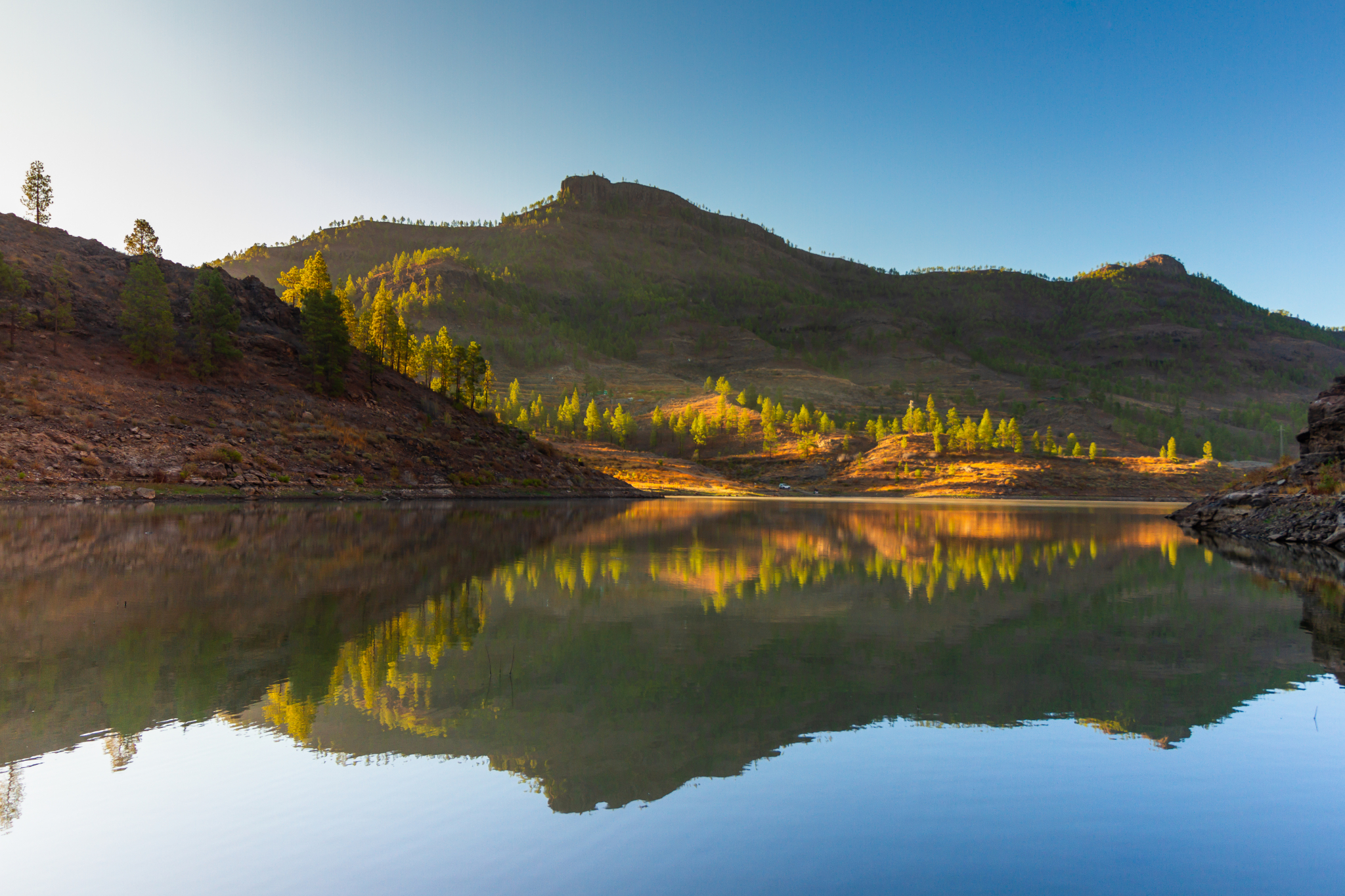 East Gran Canaria is a windy place and its windmills often generate more power than the island can use. When this happens they have to be switched off, thus wasting a huge amount of potential green energy.
East Gran Canaria is a windy place and its windmills often generate more power than the island can use. When this happens they have to be switched off, thus wasting a huge amount of potential green energy.
The solution is to use two of the island's big mountain reservoirs as a giant battery to store excess wind energy.
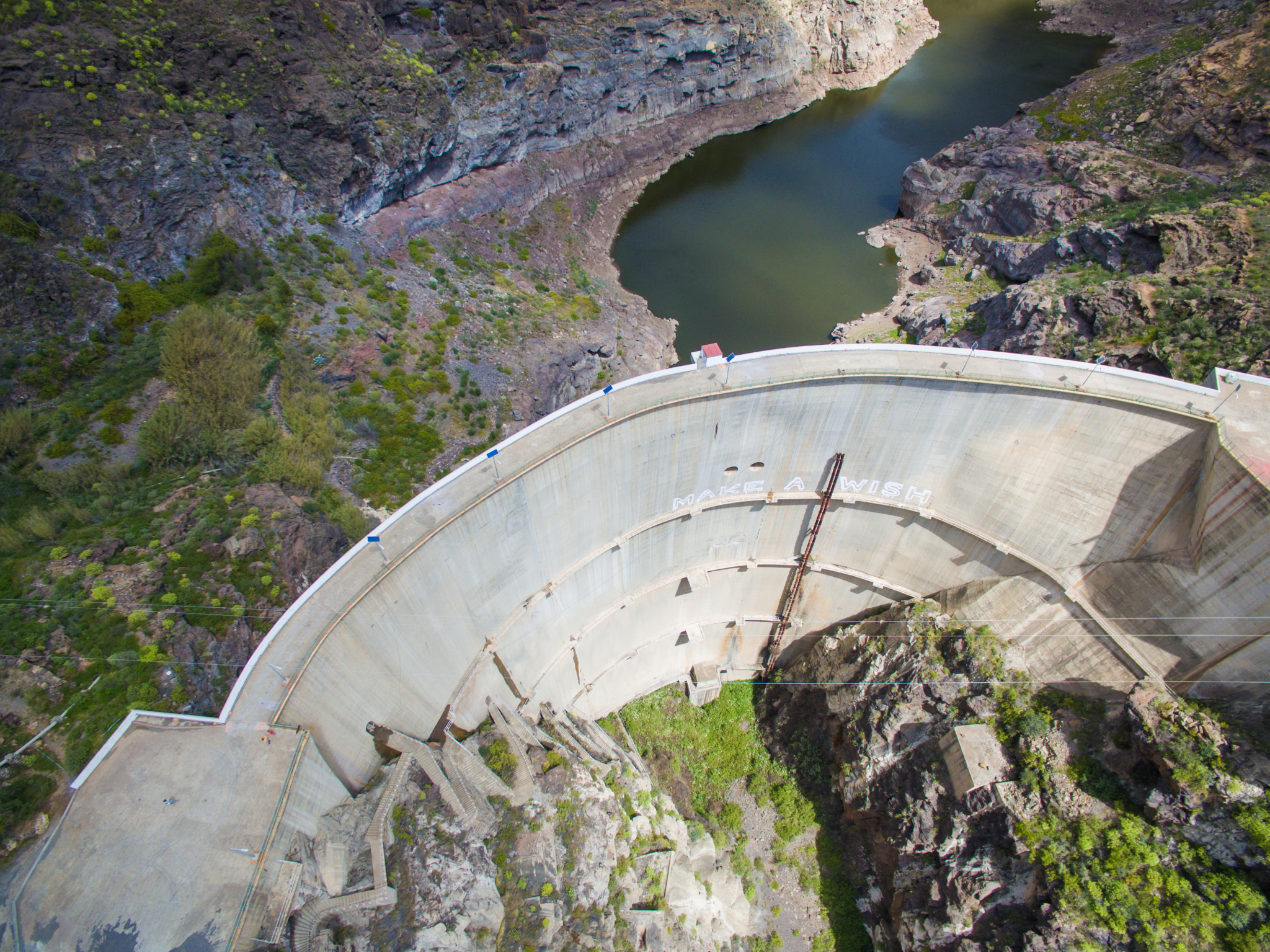 The way it works is very simple: Excess power generated from windmills pumps recycled water up to the Presa de Chira reservoir. When extra energy is needed this water runs down through a rock tunnel and drives turbines to make electricity. The water is stored in the lower Presa de Soria. From here it can either be used to water farmland, or pumped back up the hill when there is an excess of wind energy.
The way it works is very simple: Excess power generated from windmills pumps recycled water up to the Presa de Chira reservoir. When extra energy is needed this water runs down through a rock tunnel and drives turbines to make electricity. The water is stored in the lower Presa de Soria. From here it can either be used to water farmland, or pumped back up the hill when there is an excess of wind energy.
It's a clever and green way to reduce the island's dependence on burning oil to make electricity.
 However, the project is not popular with some of the islands ecologists who say it will damage pristine areas of the island (there will be some pylons) disturb the locals (the tunnel and turbines need some blasting work) and will be a for-profit operation (a Spanish power company has the concession).
However, the project is not popular with some of the islands ecologists who say it will damage pristine areas of the island (there will be some pylons) disturb the locals (the tunnel and turbines need some blasting work) and will be a for-profit operation (a Spanish power company has the concession).
Another complaint is that alternatives to the water battery could be better. However, these rely on experimental new tech such as hydrogen generation that just isn't ready to go.
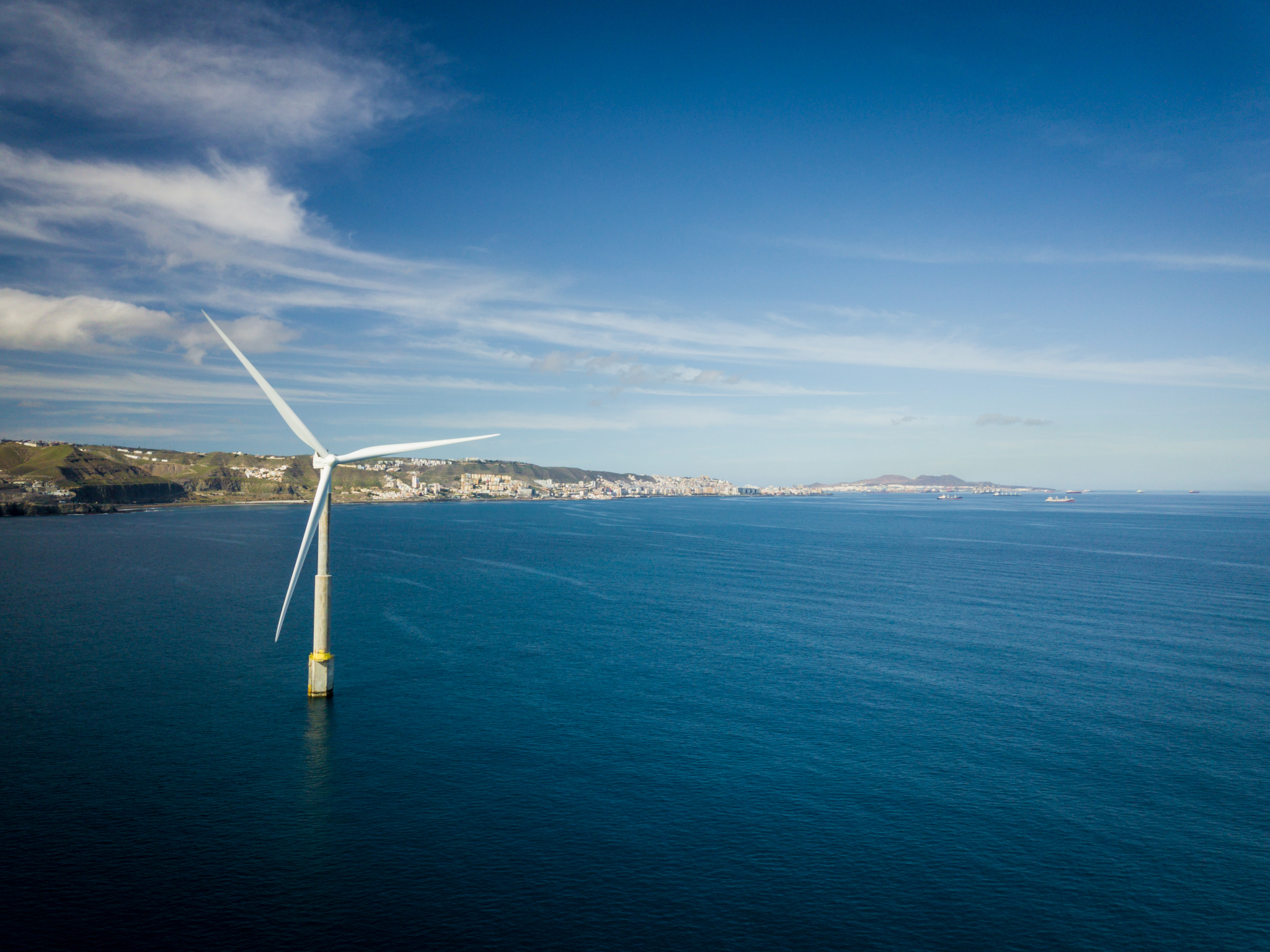 In balance we at Gran Canaria Info believe that the Chirea Soria water battery is a good idea.
In balance we at Gran Canaria Info believe that the Chirea Soria water battery is a good idea.
It means that at least half the island's electricity will be wind-generated (and that's with the island's current turbines). With offshore wind and solar power added, it could allow the island to go completely green.
Green energy research in Gran Canaria
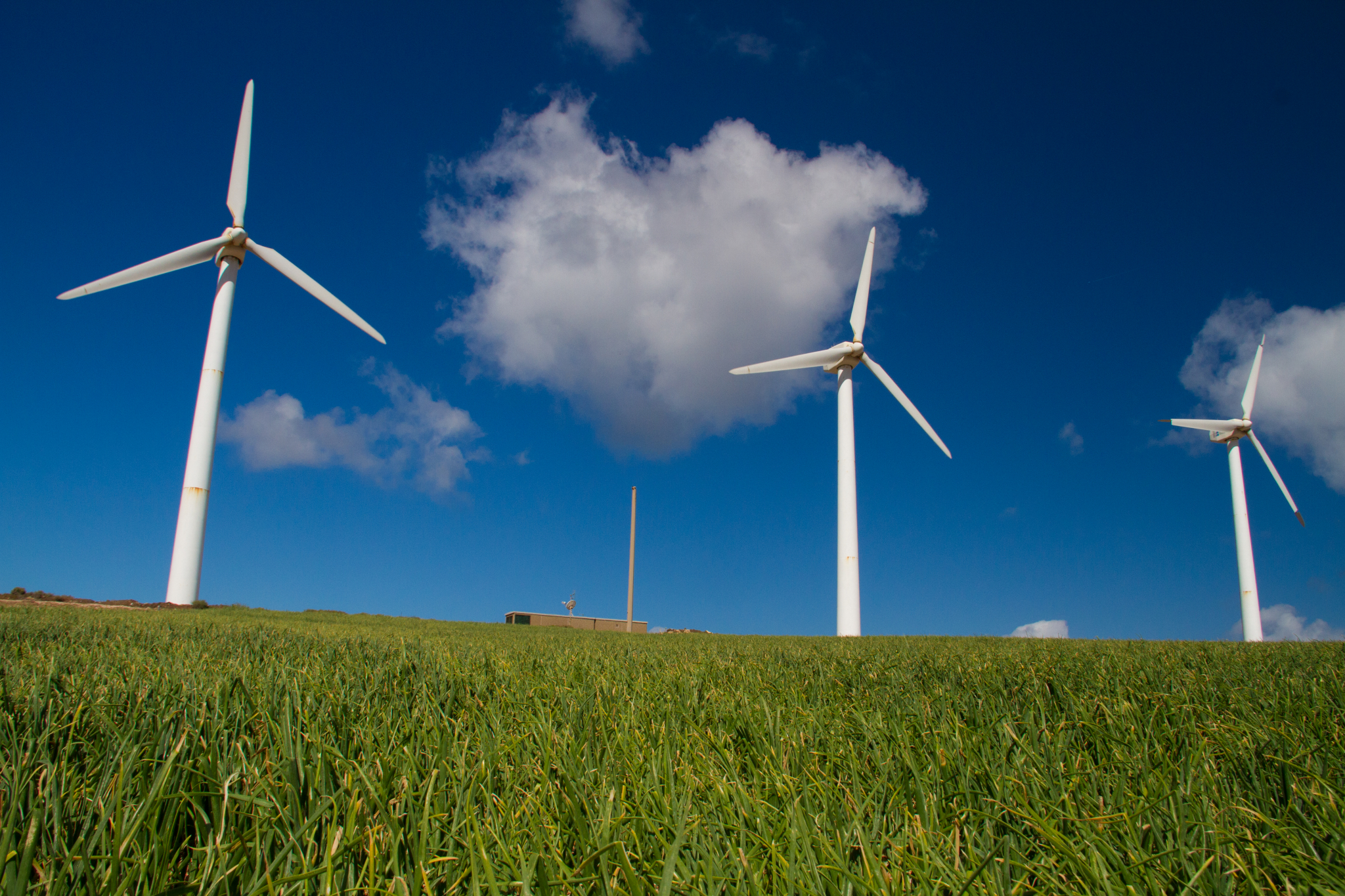 As you drive north from the airport to Las Palmas you see a huge grey square floating in the sea. This is the PLOCAN marine research station dedicated to investigating new ways to generate wind and wave power in the ocean. The Canary Islands also have experimental offshore wind farms,solar energy plants and a whole range of other green energy projects. With the ocean, wind and sunshine of the Canary Islands, it is a matter of time before we become energy independent and no longer need to generate carbon to keep the lights on.
As you drive north from the airport to Las Palmas you see a huge grey square floating in the sea. This is the PLOCAN marine research station dedicated to investigating new ways to generate wind and wave power in the ocean. The Canary Islands also have experimental offshore wind farms,solar energy plants and a whole range of other green energy projects. With the ocean, wind and sunshine of the Canary Islands, it is a matter of time before we become energy independent and no longer need to generate carbon to keep the lights on.
A green levy or eco tax on tourists
 Tourism is an energy and resource-intensive business. Visitors want to reduce their carbon footprint but they also want fresh towels, green golf courses and air-conditioning. To compensate for the extra burden on the island's resources, politicians have suggested a small levy or tourist tax paid by every visitor. The funds would be invested, in things like reforestation, offshore reefs, low carbon transport and rewilding of abandoned farmland, to reduce the island's carbon footprint and counter the effects of tourism on the environment.
Tourism is an energy and resource-intensive business. Visitors want to reduce their carbon footprint but they also want fresh towels, green golf courses and air-conditioning. To compensate for the extra burden on the island's resources, politicians have suggested a small levy or tourist tax paid by every visitor. The funds would be invested, in things like reforestation, offshore reefs, low carbon transport and rewilding of abandoned farmland, to reduce the island's carbon footprint and counter the effects of tourism on the environment.
The benefit of this idea is that it would generate a large sum of money right away. The downsides are that it would be hard to collect, and some people would choose to go to other destinations that don't have a green levy. Another issue is how to decide who spends the money and on which projects. Politicians love coming up with ways to get more money but aren't always very good at spending it effectively.
Indirect taxes on visitor spend
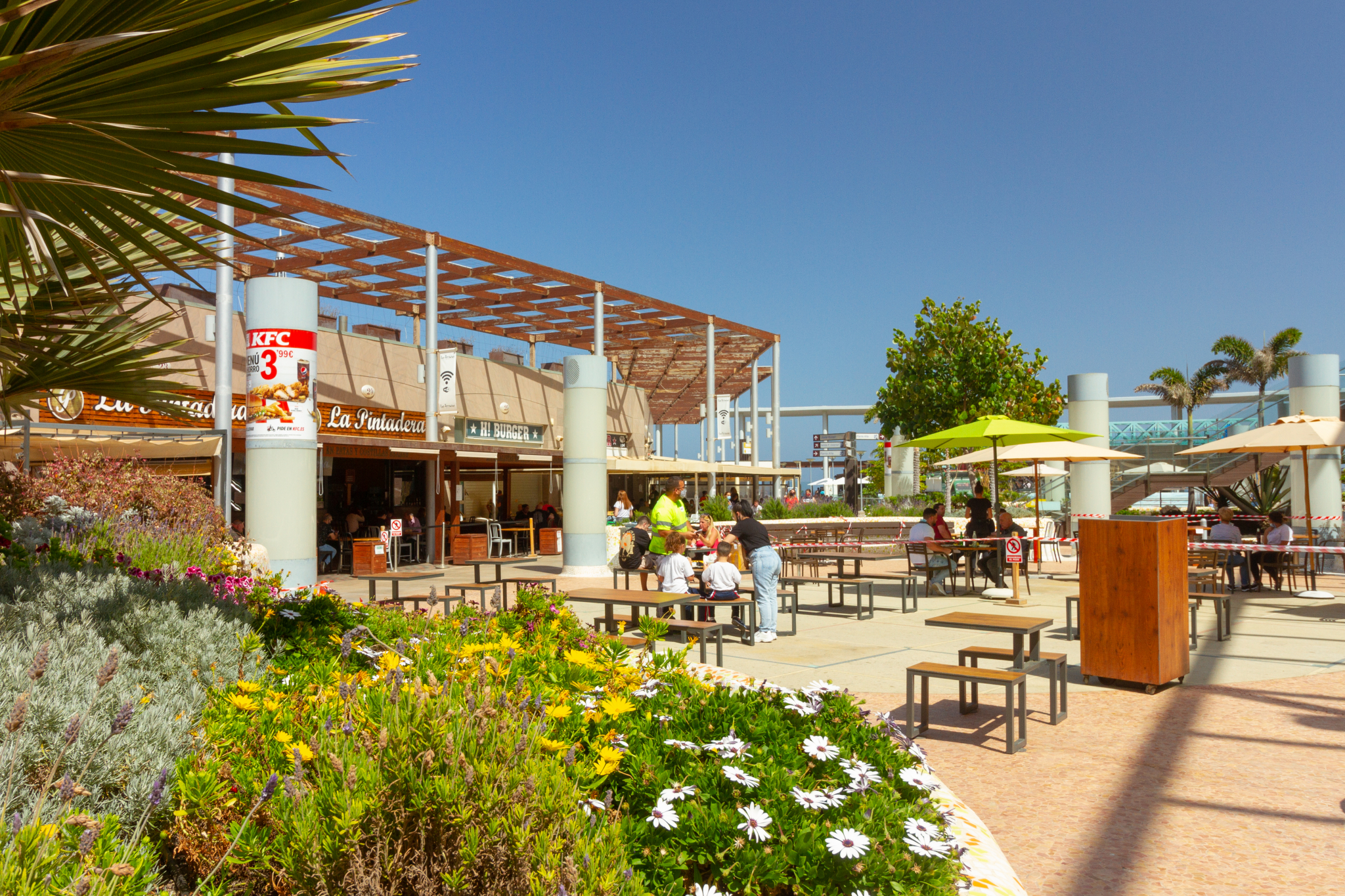 Instead of taxing every visitor, some think it would be better to add a green tax to certain things that damage the local environment or are cheap in the Canary Islands ton start with. For example, a surcharge on the price of petrol, or on luxury goods like perfume, premium alcohol and / or tobacco.
Instead of taxing every visitor, some think it would be better to add a green tax to certain things that damage the local environment or are cheap in the Canary Islands ton start with. For example, a surcharge on the price of petrol, or on luxury goods like perfume, premium alcohol and / or tobacco.
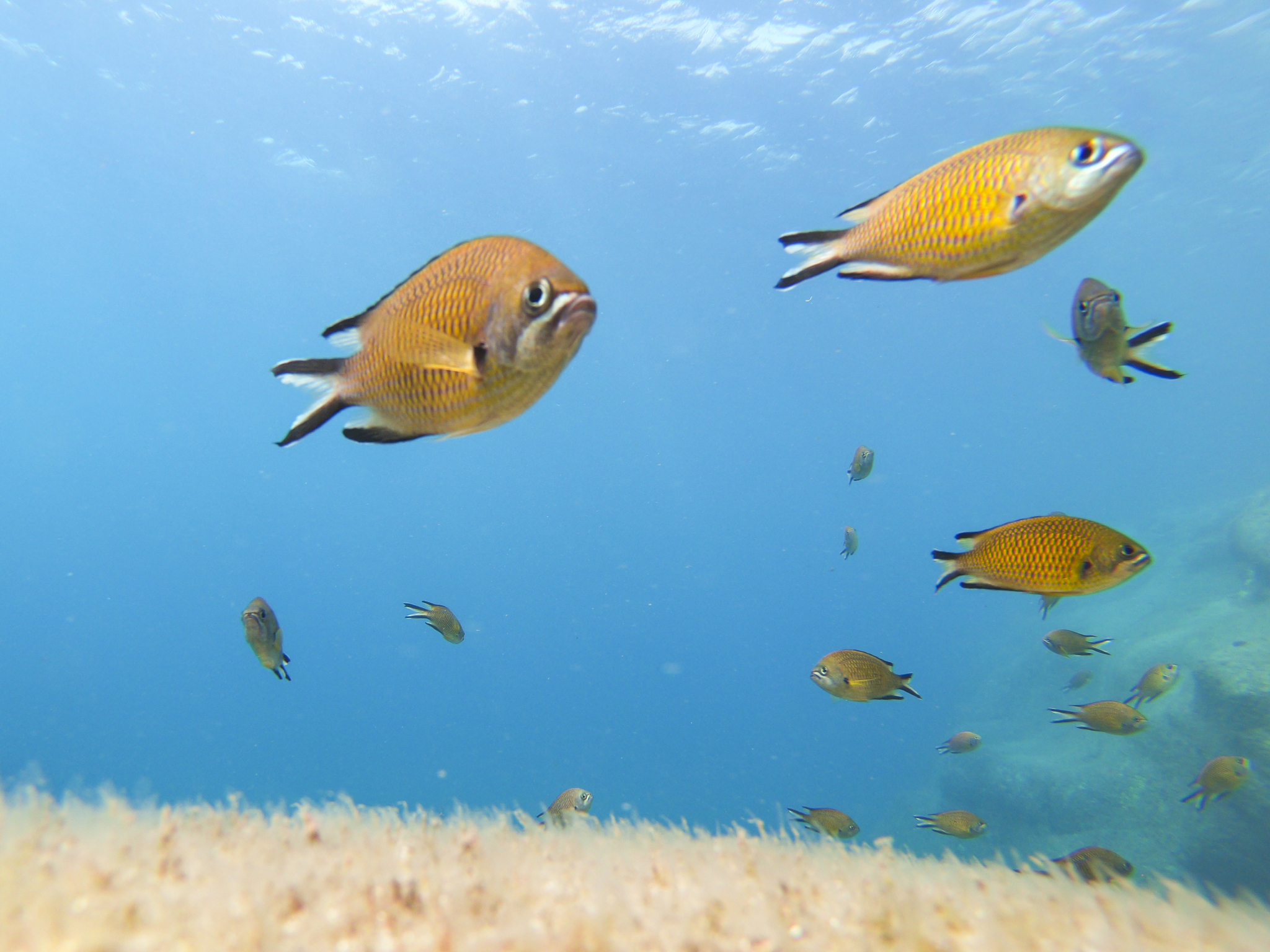 Or, what if every hotel and large tourism business in the Canary Islands chose a carbon offset project and agreed to use a percentage of their profits to funding it. They could then show their guests and customers exactly what they were doing to reduce the environmental income of their holidays. For example sponsoring a specific rewilding or reforestation project, or contributing to an artificial offshore reef to increase marine biomass. Visitors would be able to watch a live fed of life on the reef that their hotel sponsors. Maybe on those silly giant iPads that every hotel reception has but nobody uses.
Or, what if every hotel and large tourism business in the Canary Islands chose a carbon offset project and agreed to use a percentage of their profits to funding it. They could then show their guests and customers exactly what they were doing to reduce the environmental income of their holidays. For example sponsoring a specific rewilding or reforestation project, or contributing to an artificial offshore reef to increase marine biomass. Visitors would be able to watch a live fed of life on the reef that their hotel sponsors. Maybe on those silly giant iPads that every hotel reception has but nobody uses.
Carbon Offset Schemes like reforestation and rewilding
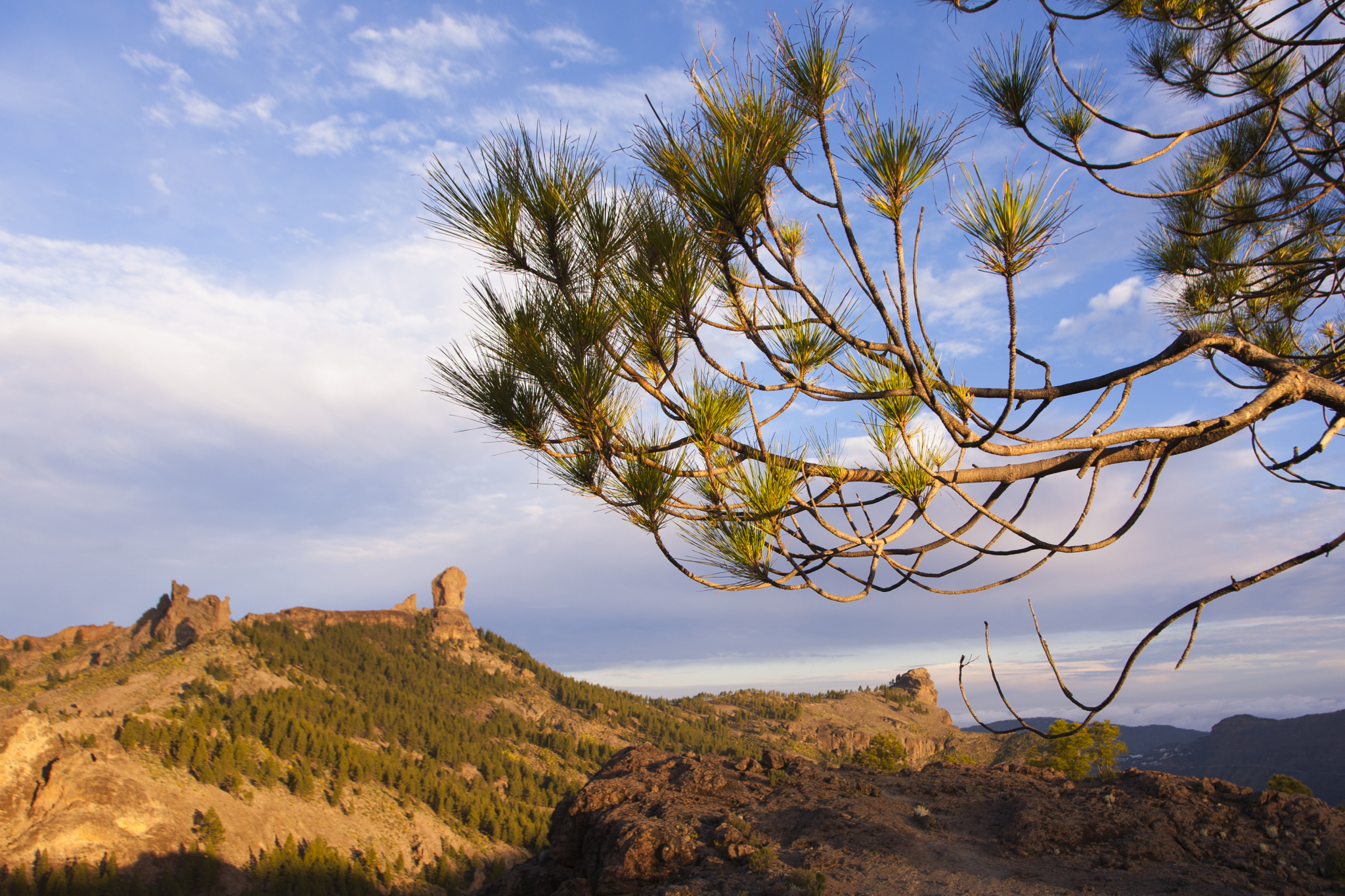 However it is paid for, rewilding and reforestation are going to be a major way that Gran Canaria offsets the carbon generated by visitors. The island now has 20,000 hectares of forest but once had over 150,000 hectares of pine, laurel, tree heath, wax myrtle and olive forests. Some of this is now occupied by towns, roads and farmland but there is a lot of space for replanting the forests.
However it is paid for, rewilding and reforestation are going to be a major way that Gran Canaria offsets the carbon generated by visitors. The island now has 20,000 hectares of forest but once had over 150,000 hectares of pine, laurel, tree heath, wax myrtle and olive forests. Some of this is now occupied by towns, roads and farmland but there is a lot of space for replanting the forests.
Other rewilding projects could include returning the abandoned farmland of the east and south coast to their natural state with native palm trees and vegetation.
See our detailed guide to the reforesting of Gran Canaria.
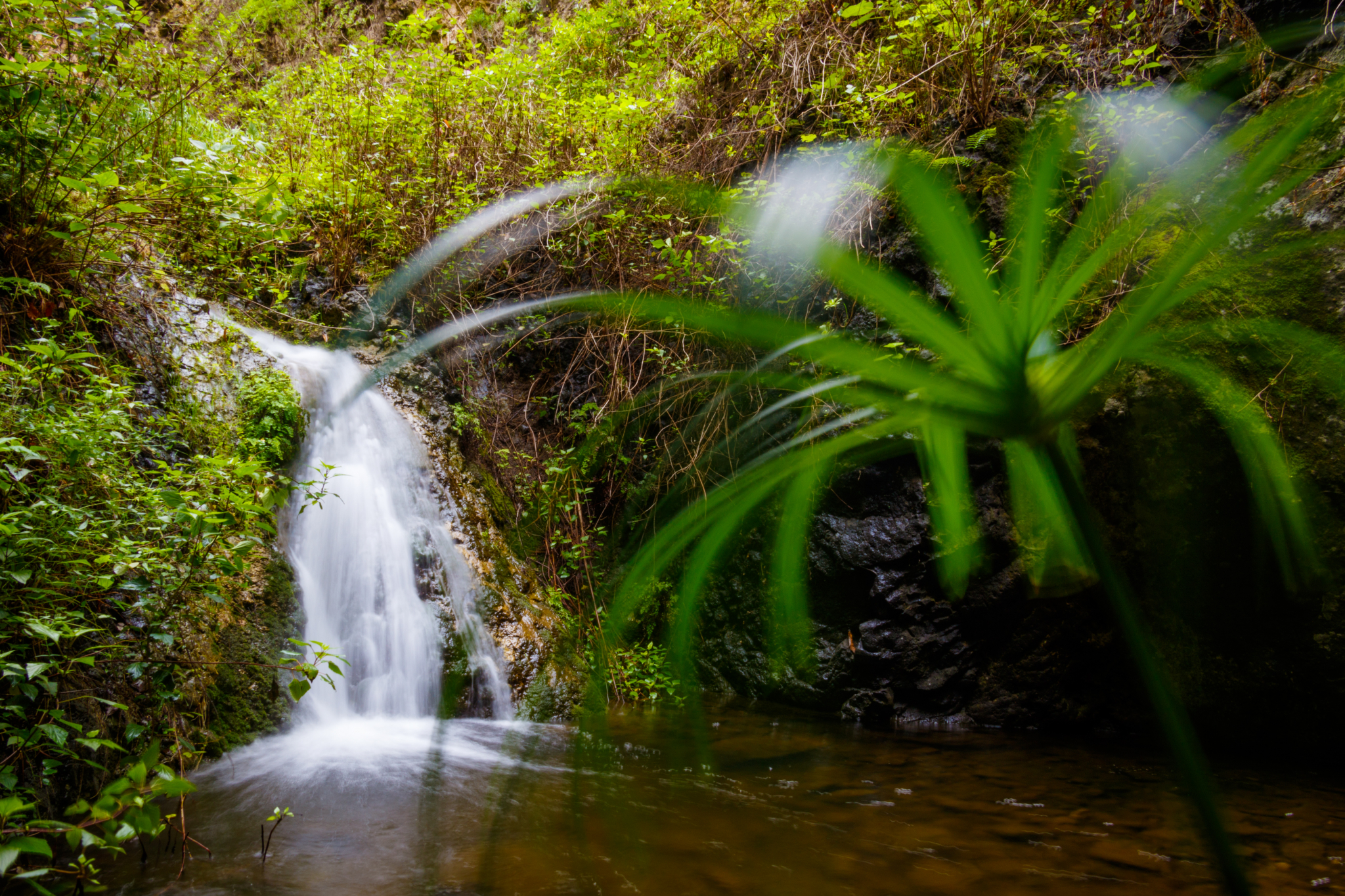 Another important idea is to return Gran Canaria's natural water to the island's valleys. Gran Canaria is not a dry island but most of its water is currently piped from source to banana and tomato farms. It would be far more valuable flowing free to created natural firebreaks and new areas of natural beauty such as streams and waterfalls.
Another important idea is to return Gran Canaria's natural water to the island's valleys. Gran Canaria is not a dry island but most of its water is currently piped from source to banana and tomato farms. It would be far more valuable flowing free to created natural firebreaks and new areas of natural beauty such as streams and waterfalls.
Low carbon transport and travel
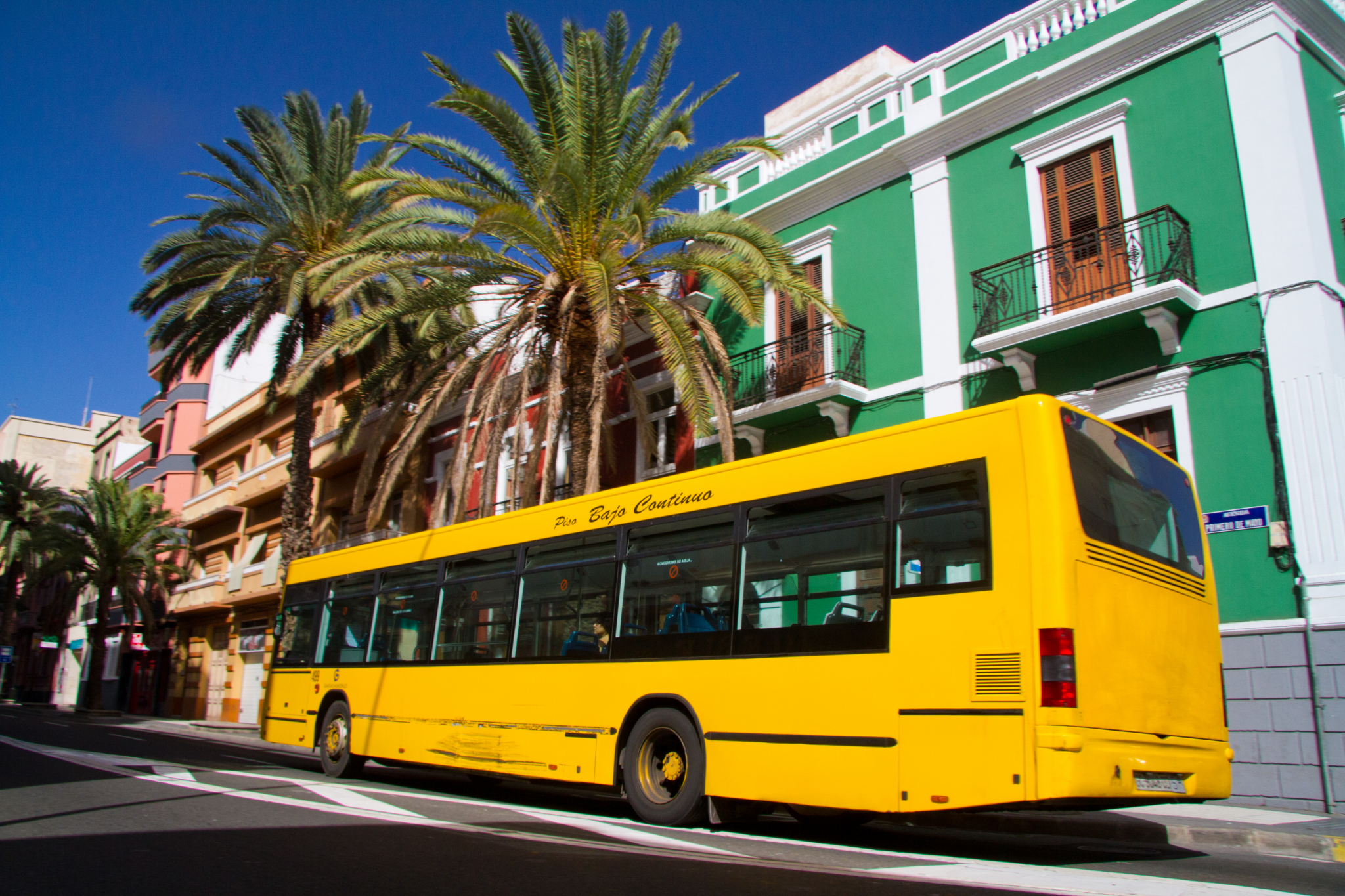 For visitors to Gran Canaria, using public transport, taking care with water and electricity use and eating only sustainable meat (such as grass-fed Spanish or Uruguayan beef) are small but significant ways to reduce their carbon footprint. Here's a good list of ways to reduce the impact of your next holiday.
For visitors to Gran Canaria, using public transport, taking care with water and electricity use and eating only sustainable meat (such as grass-fed Spanish or Uruguayan beef) are small but significant ways to reduce their carbon footprint. Here's a good list of ways to reduce the impact of your next holiday.
Consuming local produce such as wine, cheese, fruits and vegetables also contributes to reducing emissions on imports and supporting rural life in Gran Canaria.
If you want to do more, then there is a local charity that does a superb job...
Foresta: The Gran Canaria reforestation charity
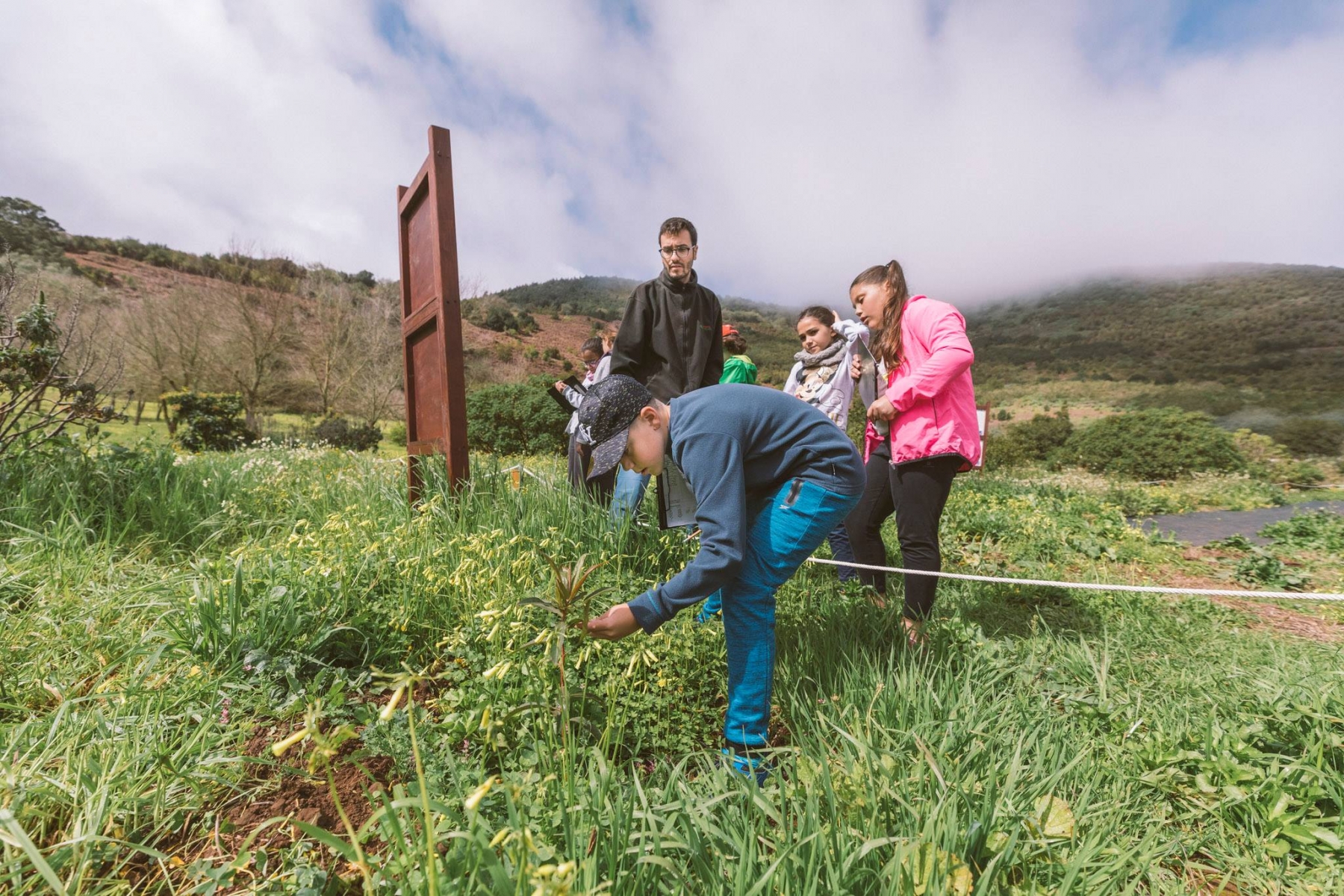 The Foresta Foundation is dedicated to replanting all of Gran Canaria's primeval forests in a sustainable and fire-safe way. It plants mixed forests of native species making sure that the right trees go in the right places. This makes the forests grow faster and also makes them more resistant to forest fires and droughts.
The Foresta Foundation is dedicated to replanting all of Gran Canaria's primeval forests in a sustainable and fire-safe way. It plants mixed forests of native species making sure that the right trees go in the right places. This makes the forests grow faster and also makes them more resistant to forest fires and droughts.
 To offset the carbon footprint of your flight to and from Gran Canaria you can sponsor a tree via Foresta. It plants one native tree sapling per donation in an appropriate location and cares for it (rabbit-proof fencing, watering, etc) until it gets established. A mature tree can absorb 1000 kg of carbon dioxide during its lifetime, more than enough to offset the 650kg of carbon that each return flight to Gran Canaria generates per person.
To offset the carbon footprint of your flight to and from Gran Canaria you can sponsor a tree via Foresta. It plants one native tree sapling per donation in an appropriate location and cares for it (rabbit-proof fencing, watering, etc) until it gets established. A mature tree can absorb 1000 kg of carbon dioxide during its lifetime, more than enough to offset the 650kg of carbon that each return flight to Gran Canaria generates per person.
Gran Canaria Info recommends:
- Default
- Title
- Date
- Random






















